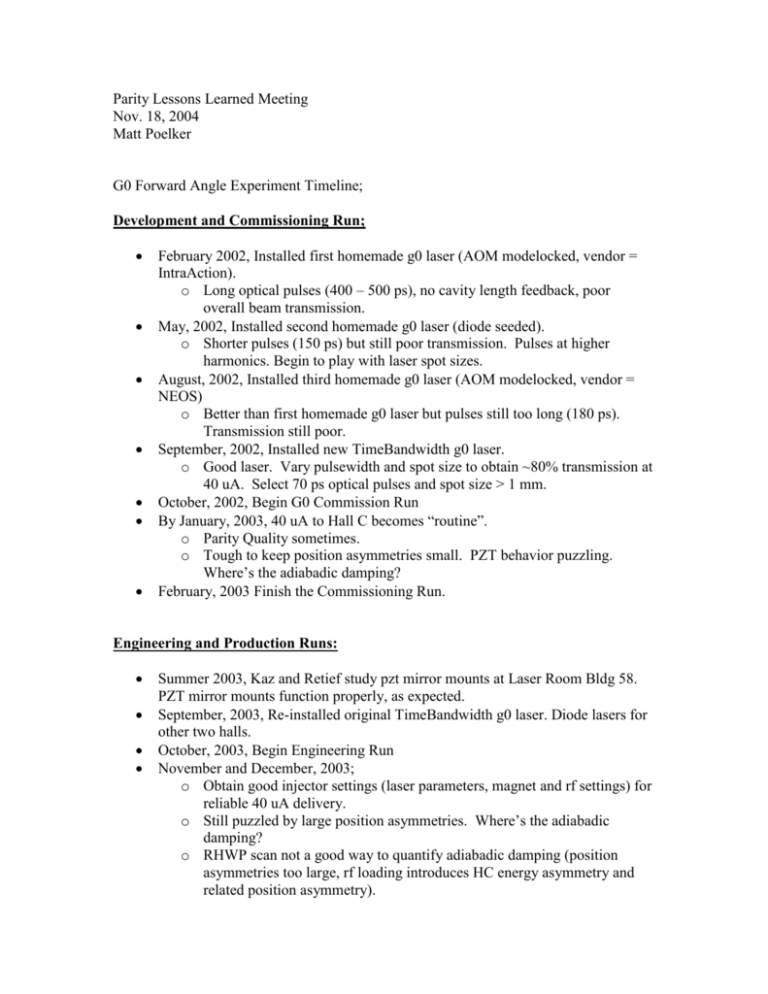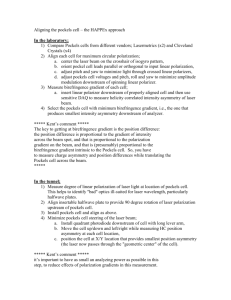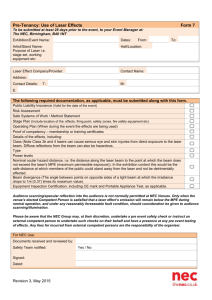MS-Word
advertisement

Parity Lessons Learned Meeting Nov. 18, 2004 Matt Poelker G0 Forward Angle Experiment Timeline; Development and Commissioning Run; February 2002, Installed first homemade g0 laser (AOM modelocked, vendor = IntraAction). o Long optical pulses (400 – 500 ps), no cavity length feedback, poor overall beam transmission. May, 2002, Installed second homemade g0 laser (diode seeded). o Shorter pulses (150 ps) but still poor transmission. Pulses at higher harmonics. Begin to play with laser spot sizes. August, 2002, Installed third homemade g0 laser (AOM modelocked, vendor = NEOS) o Better than first homemade g0 laser but pulses still too long (180 ps). Transmission still poor. September, 2002, Installed new TimeBandwidth g0 laser. o Good laser. Vary pulsewidth and spot size to obtain ~80% transmission at 40 uA. Select 70 ps optical pulses and spot size > 1 mm. October, 2002, Begin G0 Commission Run By January, 2003, 40 uA to Hall C becomes “routine”. o Parity Quality sometimes. o Tough to keep position asymmetries small. PZT behavior puzzling. Where’s the adiabadic damping? February, 2003 Finish the Commissioning Run. Engineering and Production Runs: Summer 2003, Kaz and Retief study pzt mirror mounts at Laser Room Bldg 58. PZT mirror mounts function properly, as expected. September, 2003, Re-installed original TimeBandwidth g0 laser. Diode lasers for other two halls. October, 2003, Begin Engineering Run November and December, 2003; o Obtain good injector settings (laser parameters, magnet and rf settings) for reliable 40 uA delivery. o Still puzzled by large position asymmetries. Where’s the adiabadic damping? o RHWP scan not a good way to quantify adiabadic damping (position asymmetries too large, rf loading introduces HC energy asymmetry and related position asymmetry). o Develop keen awareness of the coupled nature of each HC parameter. o Use common pzt mirror to quantify adiabadic damping. Important to keep charge asymmetry small. December 24, Installed a new g0 TimeBandwidth laser, one with better wavelength tuning range and more output power. Installed a 499 MHz TiSapphire Ocelot laser for Hall A (in retrospect, this was a good move; much less leakage, bleedthrough, cross talk). January, 2004, Complete the Engineering Run with Parity Quality beam. o Begin Hall A Hypernuclear Experiment. Modify injector to provide small energy spread. An added burden February – mid-April, 2004, Production running. Fairly reliable ops; o ~ Reproducible settings. ~ stable injector beam orbit o Rotating half waveplate provides ~ common position and charge asymmetry null for halfwave plate IN and OUT. o IA sometimes railed, pockel cell voltages sometimes adjusted. o position feedback ~ reliable. o 499 MHz beam leakage from other two lasers problematic. HAPPEx-I Timeline December, 1997. Parity Violation experiment feasibility study with original CEBAF polarized gun. Modest beam current ~ 35 uA, poor lifetime. Results very favorable. HC asymmetries small. HAPPEx-I green light. Spring 1998 HAPPEx-I part A “new” Vertical NEG gun and bulk GaAs 100 uA beam deliver at ~ 35% polarization ~ 80 C beam total charge delivered Commission the 5 MeV Mott polarimeter Feedback = PITA, i.e., vary the voltages at pockels cell + microscope slide downstream. (no rotating halfwave plate, no pzt mirror) Spring 1999 HAPPEx-I part B High polarization strained layer GaAs for beam polarization ~ 70% Maximum beam current ~ 50 uA (limited by diode lasers and low QE) Introduce rotating half waveplate downstream of pockels cell Commission Hall A Moeller and Compton polarimeters.? Feedback = PITA + RHWP HAPPEx-II Timeline Summer 2004, Pockels cell studies at Laser Room Bldg 58 (Kauffman, Humensky, Paschke, Snyder). o characterize multiple cells, find ones with smallest birefringence gradient o develop procedure for minimizing position asymmetry (find geometric center of cell) May 2004, begin using gun3 with superlattice photocathode (Pentaquark experiment at Hall A) ~ June 9, 2004. Begin HAPPEx-He o June 6 and 7, 2004 HAPPEx aligns gun3 pockels cell o 40 uA beam current instead of 80 uA o PITA feedback (pockels cell voltages) + rotating half waveplate. No position feedback. o ~ June 18, 2004 Complete HAPPEx- He ~ June 19, 2004 Begin HAPPEx-H. o Still using gun3 and superlattice photocathode but lifetime is poor, spot moves daily. HC asymmetries are not stable. o July 5, 2004 Decide to switch to gun2 and strained layer GaAs photocathode o July 6, 7, 2004, Align gun2 pockels cell. o July 29, 2004, HAPPEx-II complete G0 Forward Angle Beam Quality Results; From Kaz Nakahara’s talk PAVI 04 Total of 744 hours (103 Coulombs) of parity quality beam with a 4 cut on parity quality. Beam Parameter Achieved (IN-OUT) “Specs” Charge asymmetry -0.28 ± 0.28 ppm 1 ppm x position differences 6 ± 4 nm 20 nm y position differences 8 ± 4 nm 20 nm x angle differences 2 ± 0.3 nrad 2 nrad y angle differences 3 ± 0.5 nrad 2 nrad Energy differences 58 ± 4 eV 75 eV (19 ppb – poelker) (25 ppb – poelker) HAPPEx-II Helicity Correlated Beam Quality Results From Kent Paschke For Helium: Monitor 12x (energy) 4bx (pos) Angle –x 4by (pos) Angle-y Charge Delta 5.6 ppb 8.6 nm 6.4 nrad 2.8 nm 2.2 nrad 0.1 ppm Expected convergence, 1 sigma 2.6 ppb 3 nm 2 nrad 2 nm 2 nrad 0.4 ppm Specs 20 ppb 3 nm 3 nrad 3 nm 3 nrad 0.6 ppm Delta 22 ppb -6.4 nm -10 nrad 2.1 nm 1.8 nrad 1.7 ppm Expected convergence, 1 sigma 2 ppb 2.2 nm 1.7 nrad 2.3 nm 1.5 nrad 0.2 ppm Specs 13 ppb 2 nm 2 nrad 2 nm 2 nrad 0.6 ppm For Hydrogen: Monitor 12x (energy) 4bx (pos) Angle –x 4by (pos) Angle-y Charge Aligning the pockels cell – the HAPPEx approach In the laboratory; 1) Compare Pockels cells from different vendors; Lasermetrics (x2) and Cleveland Crystals (x4) 2) Align each cell for maximum circular polarization; a. center the laser beam on the crosshair of isogyro pattern, b. orient pockel cell leads parallel or orthogonal to input linear polarization, c. adjust pitch and yaw to minimize light through crossed linear polarizers, d. adjust pockels cell voltages and pitch, roll and yaw to minimize amplitude modulation downstream of spinning linear polarizer. 3) Measure birefringence gradient of each cell; a. insert linear polarizer downstream of properly aligned cell and then use sensitive DAQ to measure helicity correlated intensity asymmetry of laser beam. 4) Select the pockels cell with minimum birefringence gradient, i.e., the one that produces smallest intensity asymmetry downstream of analyzer. ***** Kent’s comment ***** The key to getting at birefringence gradient is the position difference: the position difference is proportional to the gradient of intensity across the beam spot, and that is proportional to the polarization gradient on the beam, and that is (presumably) proportional to the birefringence gradient intrinsic to the Pockels cell. So, you have to measure charge asymmetry and position differences while translating the Pockels cell across the beam. ***** In the tunnel; 1) Measure degree of linear polarization of laser light at location of pockels cell. This helps to identify "bad" optics ill-suited for laser wavelength, particularly halfwave plates. 2) Align insertable halfwave plate to provide 90 degree rotation of laser polarization upstream of pockels cell. 3) Install pockels cell and align as above. 4) Minimize pockels cell steering of the laser beam; a. Install quadrant photodiode downstream of cell with long lever arm, b. Move the cell up/down and left/right while measuring HC position asymmetry at each cell location, c. position the cell at X/Y location that provides smallest position asymmetry (the laser now passes through the "geometric center" of the cell). ***** Kent’s comment ***** it’s important to have as small an analyzing power as possible in this step, to reduce effects of polarization gradients in this measurement. ***** 5) Finish by measuring the effective "analyzing power" of the aligned laser system (pockels cell and all optical components, except the vacuum window). This provides a measure of the uniformity of the laser polarization across the beam profile and helps distinguish effects associated with steering and birefringence gradient. Procedure; a. insert linear polarizer downstream of cell and measure HC intensity asymmetry versus pockel cell voltages. The HC intensity asymmetry data should be centered about 0 at the ideal cell voltages. ***** Kent’s comment ***** The key here really isn't measuring the analyzing power... that is somewhat arbitrary as the cathode presumably dominates the analyzing power in the real setup, and in this test the extra pick-off mirrors might dominate. The analyzing power measurement made at this time is used to understand where other position differences come from. Ideally, one compares position differences (at this long lever arm) with and without an analyzer, and with and without the IHWP, to separate birefringence-caused position differences and steering/lensing-caused position differences. ***** Now with beam; 1) Measure HC charge and position asymmetry using a rotating halfwave plate downstream of the pockels cell with cell voltages for "ideal" circular polarization (as found in the tunnel) for insertable halfwave plate IN/OUT. HC asymmetries should be small for properly aligned cell with small birefringence gradient that is centered on geometric axis, uniform laser polarization and vacuum window with uniform index of refraction. ***** Kent’s comment ***** And, of course, various sources of position difference and charge asymmetry stand out from the "constant" term, or the terms that change as sin(2*theta) or sine(4*theta) of the halfwave plate angle, so it is a very rich data set. But certainly, it is as you say: HC asymmetries will be small if those components are ideal. ***** 2) Repeat above but for cell voltages offset by ~ 200 V, to induce significant linear polarization. Compare results to step 1. If charge asymmetry and position asymmetry track each other, HC asymmetries stem mostly from the analyzing power gradient of the photocathode (i.e., the QE anisotropy of the photocathode, for different orientations of residual linear polarized light). This is a good condition. If position and charge asymmetry do not track each other, other effects are involved, e.g., pockels cell steering and pockels cell birefringence gradient. ***** Kent’s comment ***** I guess if you have any one effect, then it’s a pretty good condition. If you have competing effects, you have to find a suitable compromise between them, so things get harder. (What you'd like to do to minimize one accentuates another.) ***** 3) Minimize charge and position asymmetries through careful choice of rotating halfwave plate orientation and pockel cell voltages. Adjustments to these parameters are made on a XX-time scale. ***** Kent’s comment ***** Ah, the time scale. Well... we found excellent stability when running off the strained layer cathode, so I would expect that they would not require detailed examination more than once a week, and maybe not even that often (detailed means RHWP scan). The PITA scans were done roughly 2-3 days, and the Pockels cell voltages were changed as required to keep the charge asymmetry <100 ppm (leaving the rest for the IA cell), usually 1-2 time daily. It is certainly possible that closer attention to these parameters may have helped damp position difference. It is also not clear that changes in injector transmission or the interaction with the Hall C beam on the cathode may have also been important. We're still trying to sort out this information. *****







